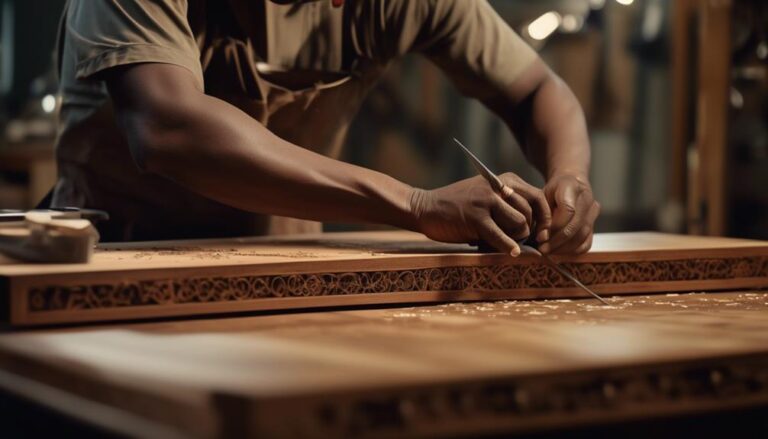In today's world, where the call for sustainability rings louder with each passing day, individuals passionate about woodworking find themselves at a crossroads. Striving to harmonize their craft with eco-conscious principles, they seek ways to minimize their environmental footprint while maintaining the integrity and beauty of their work.
This quest for sustainable practices in woodworking is not just about choosing the right materials; it's about rethinking our approach to crafting itself, ensuring that every cut contributes to a healthier planet.
Drawing from the wealth of knowledge shared by South African experts renowned for their innovative and eco-friendly woodworking techniques, this article promises a journey towards a greener workshop. By exploring methods such as the use of reclaimed wood, understanding the longevity of materials, and embracing the inherent qualities of different wood types, readers will discover actionable insights that align with their environmental values.
As we delve into these six transformative tips, rest assured that the path to reducing your ecological impact without sacrificing the artistry of your projects lies just ahead, inviting you to read on and redefine the way you engage with your craft.
Choose Sustainable Wood Species
When selecting wood for environmentally friendly projects, it is crucial to choose certified-sustainably-grown wood that aligns with the highest eco-label standards, such as FSC-certified wood. By choosing sustainable wood species, you can contribute to the preservation of our forests and reduce the overall environmental impact of your project.
One option to consider is rapidly-renewable wood species like bamboo. Bamboo grows quickly, making it an excellent choice for sustainable projects. Additionally, agricultural waste boards, made from byproducts of farming, are another eco-friendly alternative.
Abundant wood species, such as birch, cedar, and pine, are also sustainable choices. These species are readily available and have a lower impact on the environment compared to rarer or endangered wood species.
Plywood and composites are worth exploring as greener and cost-effective wood options. Plywood is made by bonding thin layers of wood together, making it a durable and resource-efficient choice. Composites, on the other hand, are engineered wood products made from recycled materials, reducing the demand for virgin wood.
Consider Fsc-Certified Options
By prioritizing the use of FSC-certified wood options, you can further enhance the environmental sustainability of your project while continuing to support the preservation of our forests. The Forest Stewardship Council (FSC) certification is the most respected eco-label for wood products, ensuring that the wood comes from responsibly managed forests. Choosing FSC-certified wood is essential as other certifications, like the Sustainable Forestry Initiative (SFI), may not guarantee the same level of sustainability.
To help you in selecting FSC-certified wood, here is a table showcasing the benefits of choosing this option:
| Benefits of FSC-Certified Wood Options |
|---|
| 1. Supports sustainable forest management |
| 2. Provides assurance of responsible sourcing |
| 3. Helps protect biodiversity and ecosystem services |
| 4. Ensures social and economic benefits for forest-dependent communities |
| 5. Meets high environmental standards |
You can find FSC-certified wood options at hardware stores, and if they are not readily available, you can request them from store managers. Educating others about the importance of FSC certification can also increase awareness and availability, encouraging more sustainable practices in the woodworking industry.
Opt for Rapidly Renewable Wood
To maximize the environmental sustainability of your woodworking project, consider opting for rapidly renewable wood. Rapidly renewable wood is a great choice for those looking to reduce their environmental impact and support sustainable forestry practices. Here are four reasons why you should opt for rapidly renewable wood:
- Sustainable Growth: Rapidly renewable wood is called so because it grows back quickly. This means that the demand for wood can be met without depleting forest resources. Softwoods like evergreens and rapidly renewable materials like bamboo and cork are excellent options for eco-friendly woodworking projects.
- Reduced Environmental Impact: By choosing rapidly renewable wood, you are actively contributing to the conservation of forest resources. This helps in preserving biodiversity, maintaining healthy ecosystems, and reducing the carbon footprint associated with the production of wood products.
- Supporting Sustainable Forestry Practices: Opting for rapidly renewable wood encourages sustainable forestry practices. These practices involve responsible harvesting, reforestation, and the protection of natural habitats, ensuring the long-term health and viability of forests.
- Alternative Eco-Friendly Materials: In addition to traditional wood options, there are also agricultural waste boards available that are made from leftover stalks. These boards offer a sustainable alternative for woodworking projects and help reduce waste by utilizing agricultural by-products.
Use Reclaimed or Recycled Wood
Using reclaimed or recycled wood is not only a sustainable sourcing option, but it also offers several benefits.
Reclaimed wood often has unique characteristics and weathered aesthetics that can add charm and character to woodworking projects.
Additionally, incorporating recycled wood from lumber stores or building scraps can help reduce waste and build a useful collection of materials for future projects.
Sustainable Sourcing Options
Utilizing reclaimed or recycled wood is a highly sustainable and environmentally-friendly option for sourcing materials in woodworking projects. Here are four sustainable sourcing options to consider:
- Lumber stores and woodworking shops often offer cheap or free scraps of reclaimed wood. This not only reduces waste but also adds character and uniqueness to your project.
- However, it is important to be cautious of embedded nails or other safety hazards in reclaimed wood. Inspect the wood carefully and remove any potential dangers before using it.
- Another sustainable sourcing option is certified-sustainably-grown wood, such as FSC-certified wood. These woods come from responsibly managed forests and ensure the preservation of natural habitats.
- Consider using rapidly-renewable and sustainable wood options like bamboo and agricultural waste boards. These materials grow quickly, reducing the strain on traditional wood sources.
Benefits of Using Reclaimed Wood
Reclaimed wood offers an array of benefits that make it a highly desirable and sustainable choice for woodworking projects. Not only does it reduce the demand for new lumber, but it also helps to prevent deforestation and minimize waste. Using reclaimed wood has a positive environmental impact by giving new life to materials that would otherwise end up in landfills. Additionally, reclaimed wood adds character and a sense of history to any project, making it a popular choice among those who value a rustic and unique aesthetic.
Here are some key benefits of using reclaimed wood:
| Benefits |
|---|
| Sustainability |
| Reduced demand for new lumber |
| Prevents deforestation |
| Minimizes waste |
| Adds character and history |
Ways to Incorporate Recycled Wood
Incorporating recycled wood into woodworking projects offers a sustainable and environmentally friendly solution that builds upon the benefits of using reclaimed materials. Here are four ways to incorporate recycled wood:
- Reclaimed or leftover wood from scrap bins: This is the most sustainable option as it repurposes wood that would otherwise go to waste.
- Forest Stewardship Council (FSC) certified wood: Look for this eco-label to ensure that the wood you use comes from responsibly managed forests.
- Rapidly-renewable wood: Consider using materials like bamboo or agricultural waste boards, which grow quickly and can be harvested sustainably.
- Abundant wood species: Opt for wood from species like birch, cedar, or pine that are abundant and support sustainable harvesting practices.
Minimize Waste and Maximize Efficiency
When it comes to minimizing waste and maximizing efficiency in wood joinery, there are several key points to consider.
First, utilizing reclaimed or leftover wood can help reduce waste and make the most of available resources.
Second, choosing sustainable wood options, such as FSC certified or rapidly-renewable materials, can ensure eco-friendly practices.
Lastly, selecting abundant wood species and exploring alternative materials like plywood and composites can further enhance efficiency in wood joinery projects.
Waste Reduction Techniques
To minimize waste and maximize efficiency in wood joinery, it is essential to employ sustainable practices and carefully select the materials used. Here are four waste reduction techniques that can help achieve this goal:
- Reclaimed or leftover wood: Utilizing reclaimed or leftover wood is the most sustainable option. It can often be found cheap or for free in lumber stores and woodworking shops, reducing the demand for new timber and minimizing waste.
- FSC-certified wood: Look for wood products with the Forest Stewardship Council (FSC) certification at hardware stores. FSC is the most respected eco-label for wood products, ensuring they come from responsibly managed forests.
- Rapidly-renewable wood: Choose wood species such as bamboo or agricultural waste boards. These materials are easier to grow sustainably and have a shorter regrowth time, reducing the impact on forests.
- Abundant wood species: Opt for wood species like birch, cedar, Douglas fir, maple, oak, and pine. These species are abundant and readily available, reducing the need for harvesting endangered tropical hardwoods.
Efficient Material Usage
By implementing efficient material usage techniques, wood joinery professionals can minimize waste and maximize efficiency in their woodworking projects. This builds upon the principles of waste reduction previously discussed.
One key aspect of efficient material usage is working with green wood. Green wood allows for wood movement, resulting in superior joints compared to kiln-dried wood. Riven wood from green logs, which has high tensile, shear, and bending strength, is a valuable material that can be utilized effectively.
Techniques such as riving and shaping wood from a log, using dry tenons in moist mortises, and final joint dimensioning after the wood has dried can help optimize material usage. It is crucial to consider principles of moisture content and shrinkage to prevent wood from warping and checking.
Wood joinery professionals can further enhance their knowledge and engagement by exploring additional resources. These resources include Fine Woodworking Forums, newsletters, podcasts, and e-learning courses.
Efficient material usage is essential in achieving sustainable and eco-friendly wood joinery practices.
Sustainable Joinery Practices
Implementing sustainable joinery practices is crucial for minimizing waste and maximizing efficiency in wood joinery projects. By following these tips, you can ensure that your joinery work aligns with eco-friendly principles:
- Opt for sustainable wood: Choose wood that is grown back as fast as it is harvested, such as FSC-certified wood or rapidly-renewable options like bamboo. Reclaimed or leftover wood from scrap bins and lumber stores is also a sustainable choice.
- Consider alternative materials: Plywood and composites can be greener options compared to solid boards, but be mindful of toxic glues. Look for environmentally-friendly alternatives.
- Choose rot-resistant wood: Select wood species that naturally resist rot, mold, and bugs. This reduces the need for chemical treatments and extends the lifespan of your joinery projects.
- Minimize waste: Plan your projects carefully to minimize leftover materials. Utilize efficient cutting techniques and consider repurposing or recycling any excess wood.
Use Non-Toxic Finishes and Adhesives
In order to promote environmentally responsible practices in wood joinery, it is essential to prioritize the use of non-toxic finishes and adhesives. By choosing non-toxic options, we can minimize the negative impact on both our health and the environment.
One way to achieve this is by opting for water-based finishes and adhesives, as they have lower levels of volatile organic compounds (VOCs) compared to their solvent-based counterparts. VOCs are chemicals that can be harmful to human health and contribute to air pollution. Therefore, selecting products labeled as VOC-free or low-VOC is crucial for maintaining healthier indoor air quality.
When it comes to finishing wood, it is worth considering natural alternatives such as oils, waxes, and shellacs. These non-toxic options not only enhance the beauty of the wood but also provide a protective layer without releasing harmful chemicals.
Additionally, bio-based adhesives are gaining popularity as environmentally friendly alternatives for wood joinery. These adhesives are made from renewable resources, reducing our reliance on fossil fuels and minimizing carbon emissions.




